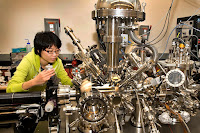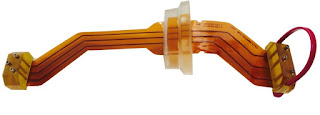 |
The challenges of getting data and
control sensors inside
vacuum equipment. |
Scientists and researchers are continually challenged to come up with better ways to read data inside a vacuum environment. Traditional ceramic and glass-to-metal vacuum feedthroughs don’t offer the flexibility of design required. Unique varieties of control and data signals have to pass through the wall. Not only are electrical power and control signals being passed, but fiber optic cables and pneumatic tubing may be included. Ever changing variables, such as the number and types of connectors, unique geometries, and limited available space, make it very difficult to find an off-the-shelf feedthrough. As a result, designers have traditionally been forced to make compromises and specify a feedthrough with some, but not all, of the desired specifications.
 |
| Custom epoxy feedthrough by BCE |
This reality has led to significant gains in
custom epoxy feedthrough development. Epoxy feedthroughs overcome design restrictions. New epoxy properties have been developed that rival ceramic and glass in performance. High performance, clear epoxy potting opens the door for researchers to specify the exact number and type of wires, fiber optic cables, or any other insert they require.
Manufacturers of epoxy feedthroughs can provide a virtually limitless variety of wires, cables, or tubes along with the added benefit of fast prototyping and small production runs - perfect for the research and manufacturing community.
Epoxy vacuum feedthroughs are quickly becoming the preferred vacuum entry device because:
- Can accommodate custom conductors, angles, and shapes.
- Prototypes with the exact number and type of have fiber-optic cables, pneumatic tubing, or run wires.
- Electrical shielding is not a problem.
- Epoxy feedthroughs are cost-effective.
- Comply with outgassing specifications.
- Allow for visual inspection when clear epoxy used.
- Feedthroughs can be mounted directly to flexible circuits and printed circuit boards.
- Elimination of contact resistance.
With the development of epoxy feedthroughs medical device companies, analyzer manufacturers, laboratories, aerospace companies, and other R&D facilities can design their equipment based on optimal size, cost and performance, and not be forced to compromise by ceramic and glass-to-metal feedthroughs limitations.
Because of the constant pressure on vacuum equipment researchers and OEM designers for “better, faster, smaller”, it’s clear that epoxy feedthroughs provide flexibility and options which allow for more efficient and creative design.
For more information regarding epoxy vacuum feedthroughs, contact:
BCE
www.belilove.com
(510) 274-1990

